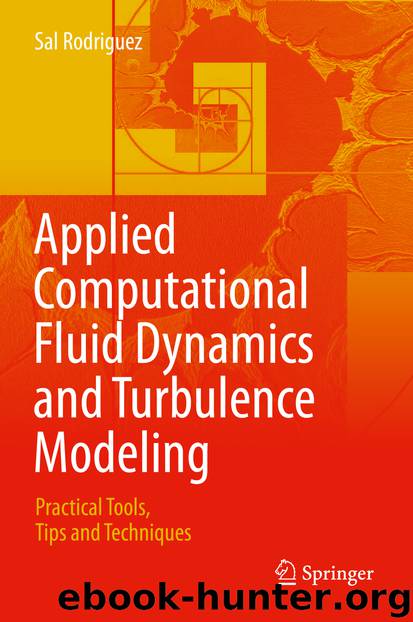Applied Computational Fluid Dynamics and Turbulence Modeling by Sal Rodriguez

Author:Sal Rodriguez
Language: eng
Format: epub
ISBN: 9783030286910
Publisher: Springer International Publishing
4.6.3.1 Kolmogorov 1942 k-ω
This is the first two-equation transport model ever developed and is now approaching the century mark (Kolmogorov 1942). Kolmogorov’s original model is discussed here for various reasons. First, it was the precursor of the modern k-ω turbulence models. Secondly, it forms the basis for other two-equation RANS models, and finally, it sheds light on the applicability of the k-ε models. Though developed too early to take advantage of modern computational power, Kolmogorov’s model contributed to modern turbulence analysis by showing that turbulence can be modeled with momentum-like transport variables that reflect key scales such as velocity, length, and so forth.
Kolmogorov began his model by noting that turbulence flows consist of “turbulent pulsations” (eddies) that range from large to small scales that are superimposed onto the mean flow. The large scales are the integral eddies, which correspond to the length scale ℓ found in modern turbulence research (Kolmogorov originally used “L”). He also used “λ” to refer to the smallest eddy scale at which the fluid viscosity dampens eddies; note that in modern notation, λ is used for Taylor eddies. In Kolmogorov’s honor, the smallest eddies are called “Kolmogorov eddies,” with modern notation using the symbol “η.”
In any case, Kolmogorov proceeded with his two-equation model development by noting that the large eddies constantly extract energy from the mean flow, and in turn, their energy is transferred onto smaller eddies. Finally, only the smallest eddies (the Kolmogorov eddies) participate in a decay process whereby they transform from tiny chaotic structures into tiny laminar regions as the dissipation of their energy is brought forth by the viscous force of the fluid. Kolmogorov described the transport of the turbulent kinetic energy as a “stream of energy, flowing constantly.” That is, he envisioned that a continuous transfer of energy existed in the fluid continuum. The process is now called “cascading.” These phenomena insights are crucial, as dissipation primarily applies to Kolmogorov eddies, but energy transfer involves all three scales—integral, Taylor, and Kolmogorov. In fact, Kolmogorov referred to his second transport variable (ω) as applicable to all (three) scales, as evidenced by his remark (Kolmogorov 1942), “A fundamental characteristic of the turbulent motion at all scales is the quantity ω which stands for the rate of dissipation in unit volume and time.”
Thus, if equilibrium is assumed, then the decay rate equals the production rate, and ω rightfully describes the energy dissipation rate under equilibrium conditions as experienced throughout the cascade—from the integral to the Kolmogorov scales. This physical description of turbulence energy flow strongly suggests which variables are appropriate and, most importantly, which form self-consistent pairs of variables for the development of two-equation turbulence models.
Kolmogorov continued his model development by postulating that ω is a “fundamental” quantity that is applicable to the entire length spectrum, because the eddy energy transfer is assumed constant—in equilibrium. Certainly, this need not always be the case in all turbulent flows but is a reasonable approximation under many situations—it forms a good starting point. Kolmogorov envisioned the fundamental
Download
This site does not store any files on its server. We only index and link to content provided by other sites. Please contact the content providers to delete copyright contents if any and email us, we'll remove relevant links or contents immediately.
| Fluid Dynamics | Thermodynamics |
The Complete Stick Figure Physics Tutorials by Allen Sarah(7338)
Secrets of Antigravity Propulsion: Tesla, UFOs, and Classified Aerospace Technology by Ph.D. Paul A. Laviolette(5333)
Thing Explainer by Randall Munroe(3909)
The River of Consciousness by Oliver Sacks(3572)
The Order of Time by Carlo Rovelli(3162)
How To by Randall Munroe(3074)
A Brief History of Time by Stephen Hawking(2992)
I Live in the Future & Here's How It Works by Nick Bilton(2960)
What If?: Serious Scientific Answers to Absurd Hypothetical Questions by Randall Munroe(2667)
The Great Unknown by Marcus du Sautoy(2662)
Midnight in Chernobyl by Adam Higginbotham(2516)
Blockchain: Ultimate Step By Step Guide To Understanding Blockchain Technology, Bitcoin Creation, and the future of Money (Novice to Expert) by Keizer Söze(2467)
Networks: An Introduction by Newman Mark(2382)
The Meaning of it All by Richard Feynman(2319)
Easy Electronics by Charles Platt(2308)
The Tao of Physics by Fritjof Capra(2247)
Midnight in Chernobyl: The Untold Story of the World's Greatest Nuclear Disaster by Adam Higginbotham(2196)
When by Daniel H Pink(2098)
Introducing Relativity by Bruce Bassett(2097)
